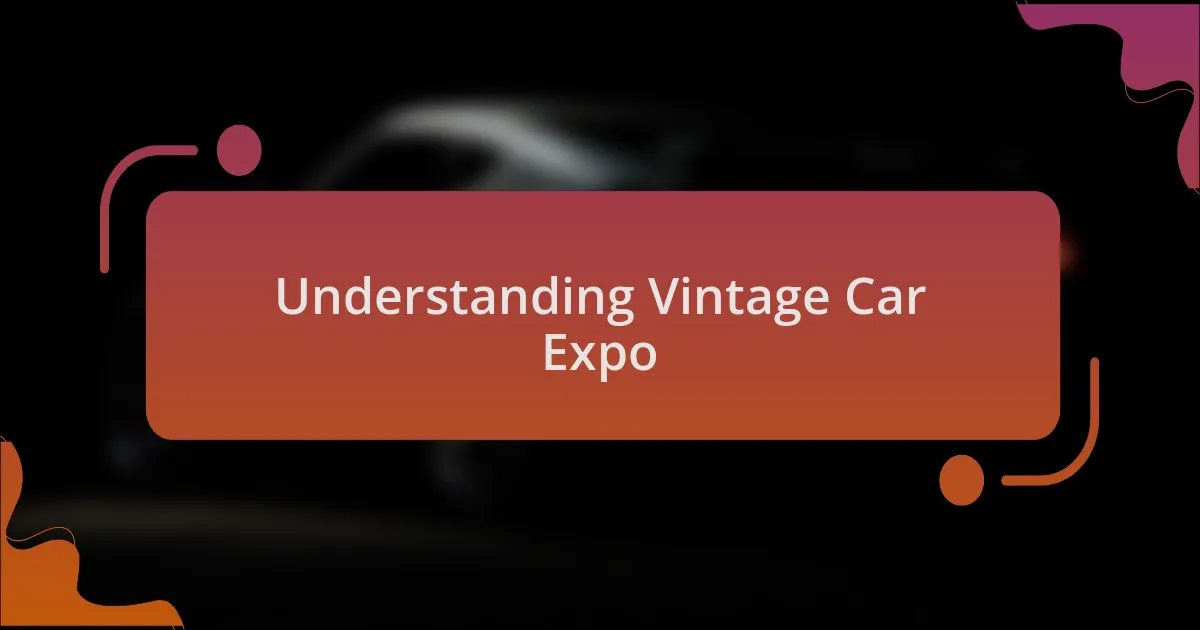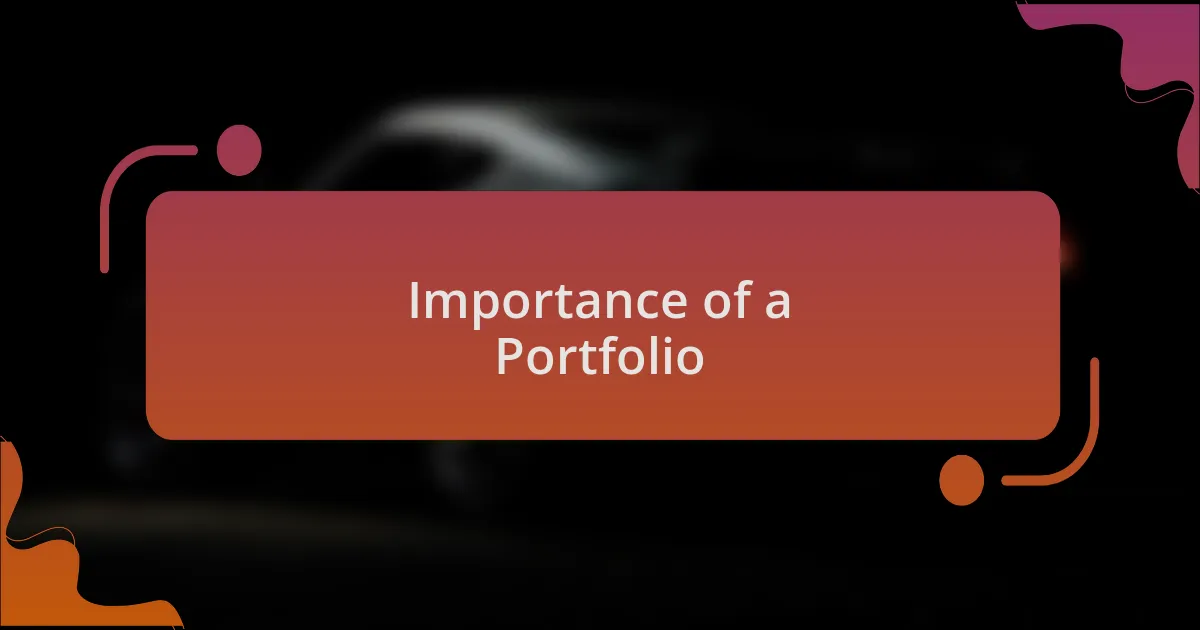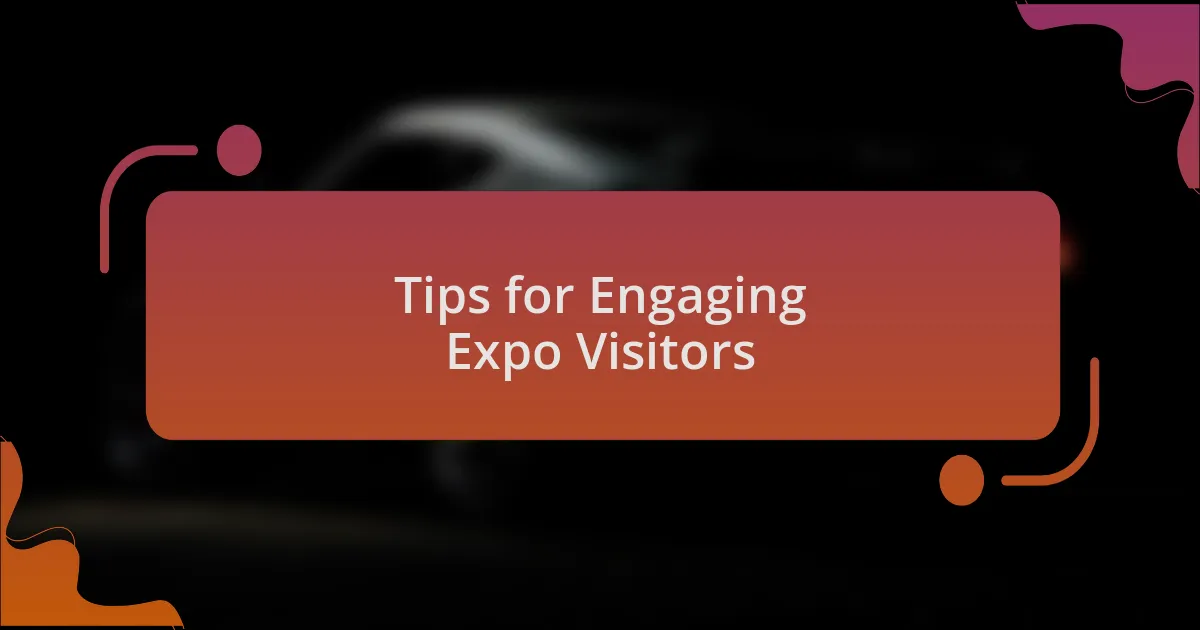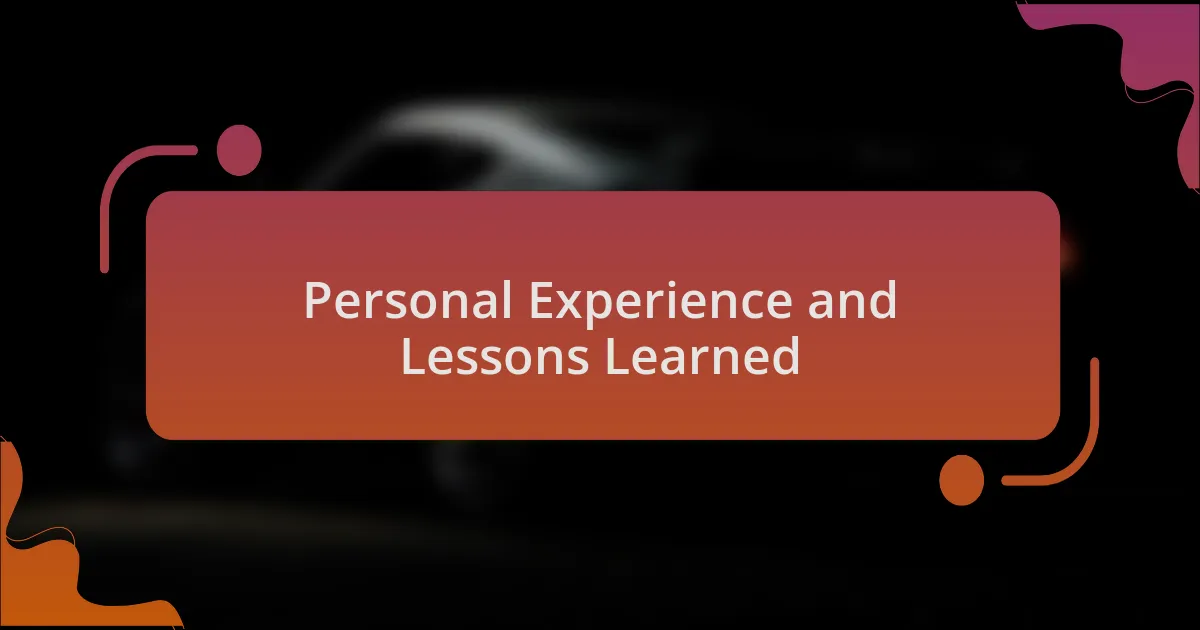Key takeaways:
- Every vintage car has its own story and emotional connection, enhancing the experience at expos.
- A well-structured portfolio showcases passion and expertise, helping to build valuable connections within the vintage car community.
- Engaging with expo visitors through personal interaction and hands-on experiences fosters deeper appreciation and lasting relationships.
- Authenticity and continuous learning are essential for effectively documenting and sharing experiences in the vintage car scene.

Understanding Vintage Car Expo
Understanding the Vintage Car Expo goes beyond just appreciating classic vehicles; it’s about the passion and artistry behind each model. I remember my first visit to such an event, where I was struck not only by the stunning designs but the stories shared by the owners. Isn’t it fascinating how each car has its own history, almost like a living, breathing museum on wheels?
When you walk through the aisles of a Vintage Car Expo, you engage in a dialogue with the past. I once came across a beautifully restored 1965 Mustang, and the owner shared how he spent years sourcing original parts. This level of dedication made me wonder: how many dreams are woven into every vehicle on display? It struck me that every nook and cranny of these cars holds memories of adventures, love, and sometimes loss.
The atmosphere at a Vintage Car Expo is electric with nostalgia and camaraderie. I often find myself exchanging smiles and stories with fellow enthusiasts, which creates an immediate bond. Isn’t it incredible how a shared love for vintage cars can connect people from diverse backgrounds? It’s in these moments that you realize: it’s not just about the cars; it’s about the community and the passion for preserving history.

Importance of a Portfolio
A portfolio plays a crucial role in showcasing your passion and expertise in the vintage car scene. I remember when I first decided to document my journey; flipping through the early pages was like reliving my adventures. Each photo I took and every story I included answered the questions: what drives me to restore these vehicles? What do they mean to me?
Having a well-structured portfolio not only highlights your skills but also conveys your unique perspective. I once attended a car show where a fellow enthusiast presented his portfolio, showcasing the nuances of vintage design. His ability to narrate the story behind each piece captivated the audience, making them more interested in the cars than ever before. Isn’t that what we want: to draw others into our world?
Furthermore, your portfolio serves as a valuable tool for networking. I’ve found that sharing my collection with industry professionals opens doors I never imagined. It invites conversation and builds connections with people who share a similar passion. Have you thought about how your journey could inspire others?

Showcasing Cars Effectively
The visual appeal of your portfolio is crucial when showcasing cars. I learned early on that a striking photo can evoke strong emotions, sometimes even nostalgia. When I captured the glossy finish of a classic Mustang just right, the image spoke volumes, telling a story of craftsmanship and history without a single word. So, ask yourself: are you using lighting and angles that reflect the soul of each car?
Incorporating details about the restoration process can also make your display more engaging. I remember sharing a time-lapse of rebuilding a 1965 Chevrolet Impala; seeing the transformation from rusted shell to stunning masterpiece left many viewers in awe. It’s fascinating how sharing the journey can deepen appreciation. What stories about your cars do you have waiting to be told?
Lastly, consider the context in which you showcase your cars. One of my favorite moments was when I displayed a vintage Volkswagen Beetle surrounded by retro memorabilia. That simple setting sparked conversations about past experiences and fond memories associated with the car. It reminded me that placing a vehicle within a relatable context can truly resonate with others. How have you framed your cars to connect emotionally with your audience?

Tips for Engaging Expo Visitors
When engaging expo visitors, I find that interacting with them personally can make a significant difference. My experience at one expo taught me the value of conversations; I set up a small quiz about vintage cars and offered prizes for correct answers. The excitement was palpable, and it created a friendly atmosphere where people felt comfortable sharing their own stories about cars they had loved or owned.
Another strategy I’ve adopted is to create a hands-on experience. During one event, I brought along some vintage car parts for attendees to touch and examine. Watching their faces light up as they learned about the mechanics and history behind each piece was incredibly rewarding. Are you allowing your visitors to feel connected to the cars not just visually, but physically and emotionally?
Capturing visitor feedback is also invaluable. After speaking with attendees, I often ask them what aspects of the cars resonated with them the most. At one exhibition, I discovered that people had a deep appreciation for the stories behind the modifications on my displayed vehicles. This connection often leads to deeper conversations and lasting relationships. What insights have you gained from your audience that could enhance your future showcases?

Personal Experience and Lessons Learned
One of the most pivotal moments in my journey was realizing that each car has its own story. I remember showcasing a beautifully restored 1965 Mustang, and as I spoke about the restoration process, an older gentleman approached me. With misty eyes, he shared how that same model had been his first car, and in that moment, I understood the emotional connections people have with vintage vehicles. Do we always recognize the nostalgia behind the metal?
I’ve also learned the importance of authenticity in my portfolio. Early on, I focused heavily on polished presentations and flashy images, but feedback showed that visitors craved genuine stories over mere aesthetics. One time, I included a photo of a dinged-up hood from a barn find, paired with a narrative about its journey. The interest it sparked was overwhelming! How can we strike a balance between showcasing beauty and honoring imperfections?
Finally, I embraced the value of continuous learning. There was a time I felt overwhelmed by the vast knowledge in the vintage car community. Attending workshops and engaging with fellow enthusiasts transformed my understanding. The more I learned, the more I realized how vital it is to share that knowledge generously. Are we not all on a journey of growth, in our love for these timeless machines?